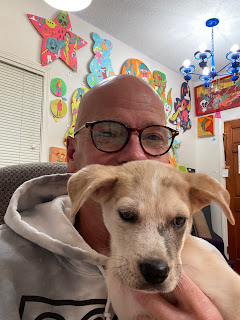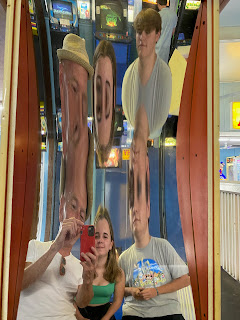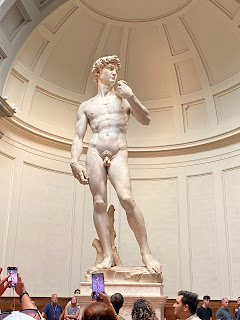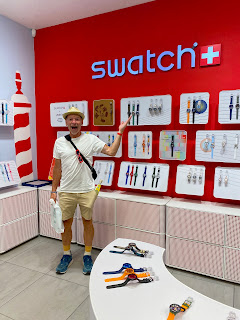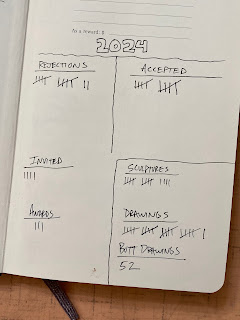Not that you asked, but I thought it might be worth sharing one of my educational principles as a
Professor of Art for more than 20 years. If you're young and you're still having to write a "philosophy of education" to get a job, you may want to roll this around in your brain and see how you may word it better and use it. If you're mid-career and still actively stealing ideas to make your teaching more effective, this one is an easy steal. And finally, if you're not in education at all, and you're still reading, I would bet this concept easily translates into whatever profession you're in or perhaps even into your personal life.
Here's the principle: Never tell a student something is impossible.
Of course, there should be a huge asterisk at the end of that and we'll get to all the exceptions later, but for now, just take it for what it says.
Sculpture is a discipline of realism. Sure, your composition may look cool with all that weight on one side of the form, but in sculpture, it has to actually stand up. Gravity is a thing, like it or not. You may not want to add another leg but the realism of gravity may demand it. You may want to make your idea 10 feet tall, but that process may take you 10 years and we only have a semester. There's an almost infinite list of examples of when the realism of science takes precedent over the idealism of the sketchbook.
My job as the professor is to look at the ideas early on and advise the student in whatever direction I know realism will take them. Lots of experience has given me the ability to look at a sketch and listen to an idea and quickly be thinking several steps ahead so that I can help the student navigate potential problems and pitfalls. Knowing they're likely to get frustrated in 3 weeks with a difficult step they don't even know exists yet allows me to adjust their "choose your own adventure" book. Rarely do I tell them why I'm giving the advice I'm giving. To do so would take more time than we have in the studio class, carefully explaining every step and providing reasons why. So what generally happens is, I look at the idea, listen to the student explain and I point them in a direction I believe will give them success.
The problem with that is I may define success differently than a student. Students are often most concerned with the finished product as they think that impacts their reputation and final grade. There's certainly some truth to that expectation, but as a teacher, I'm more concerned with the process of critical thinking and decision making they'll do along the way. This means I may know that the student will likely not be able to make the thing they're planning, but that they'll have to make choices in the creative process that will probably yield some sort of successful sculpture, just not the one they planned.
Looking at a sketch of an idea prior to the student touching the material is mostly just an assessment of their compositional skills. I'll always insist on multiple ideas and when I look at those, I'm looking for creativity and composition. If I know there's no way the reality of the material will do what they want, I may tell them and encourage them to move to a different idea. Sometimes I'll see the impossible things in the sketch and I'll take what I know about the student and decide if I should just turn them loose on the idea or steer them away.
One really good example of this occurred in August when the fall semester began. A student brought me sketches and there was a page with a blue heron sketched on it in a mostly realistic fashion. A big heavy body and some long skinny legs...not the kind of idea I would usually green light for a project made from laminated plywood. I encouraged the student to think about using abstraction to make the design better. Once they showed me those changes, I asked a couple of exploratory questions and knew that there were some potential solutions the student might discover if I let her run free. I took a second and told her to get started. Yes, if you're wondering, I did indicate my concern over the skinny legs. Just enough information to plant a seed.
In the next few weeks, the student went about carefully and meticulously creating the individual parts of the bird, all separately. This was the exploration of media. The student had never made a sculpture before and never used wood or power tools. All of it was new. There was much learning and I was happy with the progress, even as I worried that all the parts may not join together at the end.
More hours were logged and as I raised questions about physical connections, the student thought about possible solutions that fit within the project requirements. Among those were that students could only use wood and adhesive, so no nails or screws. My projects are problem-based so some of my criteria points are diabolical. I'm not ashamed.
In the final days before the deadline, I was already happy with what the student had learned. All of the things they needed to learn about carving wood and using tools safely were covered. Each part of the bird looked like the original plan and as the student started assembling the parts, from easy to difficult, things were going well.
These connections often break at least a few times. Again, diabolical, but it teaches students to plan their studio time, deal with unexpected problems and to continually critically assess their sculptures. In this student's situation, each break meant stopping progress and allowing another 12-24 hours of drying time before adding yet another heavy and precarious piece of wood.
By the day before critique, this project was a comedy of errors. I made sure I was a part of these last few studio hours so that the student would learn to laugh at the problems as they stacked up so high. This may be one of the healthiest things I can teach a student. The laughter lightened the mood and also allowed more blood to flow to her brain while she continued to problem solve. When I left for the night, the student had carefully constructed a ridiculous support system to hold the sculpture up so it could dry. Just like in the beginning, there was no way it was going to work.
In the critique, she took away all the supports and the rickety sculpture actually (kind of) stood up on its own for a minute.
That's not the student in the photo, just a kind observer who held the bird upright while it was critiqued. The bird was finished by the deadline, it was critiqued and it was very successful as a sculpture. It did not stand completely on it's own and while it was stabilized for the length of the critique, it wobbled and a couple of pieces worked their way loose. I was still very impressed that the student had carried the process so far. She had done the impossible and this was the first time I told her it was impossible. You see, if you don't tell someone it can't be done, they might just do it.
The student took the suggestions from critique and decided to keep working on the bird. She wanted it to be able to be exhibited, which meant it had to be reliably sturdy. Now that the project was over, she had the freedom to use a couple of screws if needed. We talked through some ideas and she came up with a good plan to make the bird work.
As soon as it was done, we very, very carefully transported the fragile bird to a pedestal and he survived the trip. Here he is in his 360 degree glory:
Now for those asterisks. Dude, of course you have to tell a student something is impossible when it's absolutely not possible. The last thing you want to do is have a first semester student reach their frustration level early. But how do you know when to wave a student off and when to tell them to go for it? You have to know the student. This means paying attention to every detail. You have to be ready to receive the information available about students. I'd tell you my gut said this student could handle it, but the whole truth is a little deeper. I met this student a year earlier when they made an extra effort to come to a gallery event. I saw them last spring in a Drawing class and paid attention to what they were drawing each time I passed the easel. I noted the excitement in her eyes when she signed up for Sculpture. All the signs were there.
You also have to consider your experience. I tell students "no" a good bit when they have crazy ideas. I LOVE crazy ideas, but in the case of a public sculpture, I know there are rules and best practices to follow. Having been in public sculpture for 20+ years, I know the thing isn't going to survive a drive to another location or that the glass is going to shatter or that the wind is going to blow it away.
Last, and most judgmental, you have to be honest about the student. If you've seen their work before, you just know. If they work at a snail's pace on a good day, you have to tell them there's no way they'll finish the big idea, ever. If they've struggled with quality and craftsmanship, you have to be honest about how it's going to turn out unless there's a huge change in behavior. I'll also put an asterisk here and tell you I've had students surprise me and prove me wrong, but I'm always happy to be wrong in that situation.
Last honest disclaimer:
The Impossible Bird is currently on display for all to see. As we carried it up the stairs as gently as possible, the little legs cracked and popped with each step and each giggle. One leg is currently bent under the weight of the bird and I would not be surprised if it broke from the passing of the hallway ghost late one night. Still, it survived the installation and has already lived longer than any of us expected.



